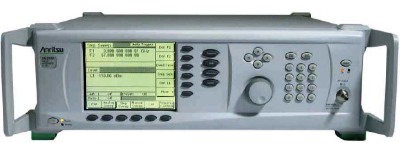
|
|
The Anritsu MG3691B 10 GHz Synthesized Signal Generator is microprocessor-based, synthesized signal source with high resolution phase-lock capability. It offers unsurpassed frequency coverage, leveled output power, spectral purity, switching speed, modulation performance, size, upgradeability, reliability, and service. The signal generator is configurable for a broad range of applications from R&D to manufacturing and depot repair. It generates both discrete CW frequencies and broad (full range) and narrow band step sweeps across the frequency range of 2 GHz to 10 GHz. Options are available to extend the low end of the frequency range to 0.1 Hz. All functions of the signal generator are fully controllable locally from the front panel or remotely (except for power on/standby) via the IEEE-488 General Purpose Interface Bus (GPIB). Specifications. Frequency Range: 2 to 10 GHz. Output Power: +19.0 (standard). CW Mode Output: Twenty independent, presettable CW frequencies (F0 – F9 and M0 –M9). Accuracy: Same as internal or external 10 MHz time base. Resolution: 0.01 Hz. Phase-Locked Step Sweep Mode nWidth: Independently selected, 0.01 Hz to full range. Every frequency step in sweep range is phase-locked. Accuracy: Same as internal or external 10 MHz time base. Resolution (Minimum Step Size): 0.01 Hz. Markers: Up to 20 independent, settable markers (F0 – F9 and M0 – M9). Options. 2X - Mechanical Step Attenuator. 2E - Electronic Step Attenuator. 3 - Ultra Low Phase Noise, main band. 4 - 10 MHz to 2.2 GHz RF coverage, Ultra-Low Phase Noise version. 5 - 10 MHz to 2 GHz RF coverage. 6 - Analog Sweep Capability. 7 - IF Up-Conversion. 8 - Power Monitor. 9X - Rear Panel Output. 10 - User-Defined Modulation Waveform Software. 12 - Frequency and Phase Modulation. 14 - Amplitude Modulation. 15X - High Power. 16 - High Stability Time Base. 17 - Delete Front Panel. 18 - mmW Bias Output. 20 - Scan Modulation. 22 - 0.1 Hz to 10 MHz Audio coverage. 26X - Pulse Modulation. 27 - Internal LF and Pulse Generators. 28X - Analog Modulation Suite. 30 - Low Phase Noise. 37A - Performance Suite. 38A - Ultra Performance Suite. 39A,B,C,D - CW Power Meter and Sensor Bundle. 40 - Pulse Power Meter and Sensor Bundle.
|